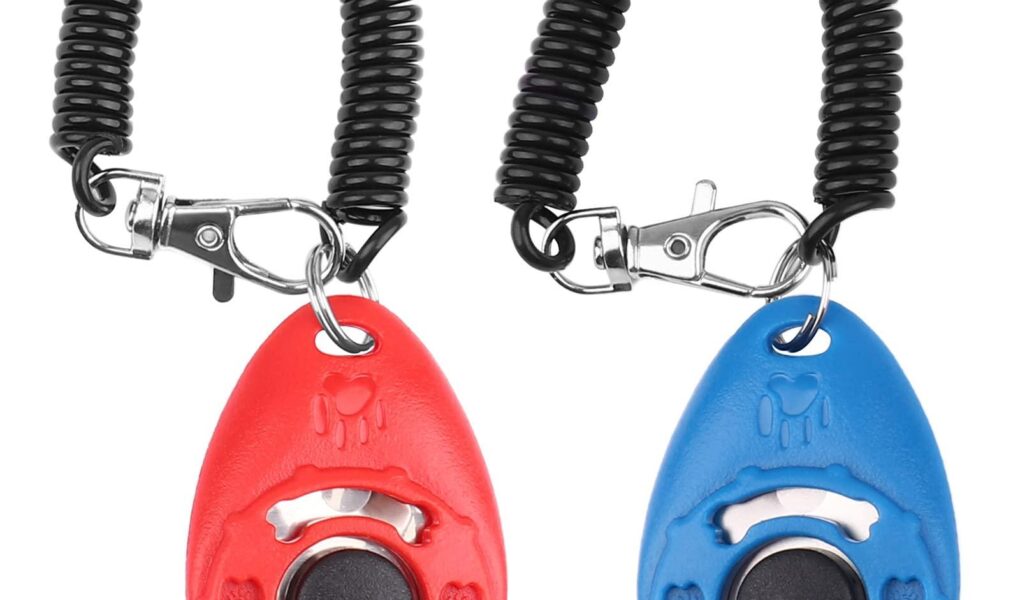Title: Unlocking Canine Communication: The Power of the Clicker
In a world where effective communication is the bridge between humans and their four-legged companions, the dog training clicker stands out as a transformative tool. Imagine, if you will, a sound that bridges the gap between species—a simple click that speaks volumes, affirming desired behavior and strengthening the bond of understanding. This small device, often no larger than a keychain, has become a favorite among trainers and pet owners alike, offering a positive and precise method for teaching dogs new skills.
The clicker method, rooted in the principles of operant conditioning, taps into the natural learning processes of dogs, providing immediate feedback that enhances the training experience for both the trainer and the pupil. Whether you’re a seasoned dog trainer or a novice eager to embark on a journey with your furry friend, the clicker opens the door to a world of possibilities. Join us as we explore the ins and outs of clicker training, highlighting its benefits, techniques, and the joy of cultivating a deeper relationship with your canine companion through the simple yet profound act of clicking.
Table of Contents
- Understanding the Clicker: The Science Behind Positive Reinforcement in Dog Training
- Effective Techniques for Using a Clicker: Step-by-Step Guidance for Dog Owners
- Choosing the Right Clicker: Features and Factors to Consider for Optimal Training
- Common Mistakes in Clicker Training: How to Avoid Pitfalls and Ensure Success
- Q&A
- To Wrap It Up
Understanding the Clicker: The Science Behind Positive Reinforcement in Dog Training
At its core, the clicker serves as a precise tool for communication between the trainer and the dog. When training, timing is everything. The click sound creates an immediate association; it tells the dog that they have performed a behavior correctly. This instant feedback differentiates the moment of success from all others, reinforcing the likelihood that the behavior will be repeated in the future. The effectiveness of the clicker lies in its unique ability to capture the moment of learning, ensuring clarity in the training process. Some additional benefits of positive reinforcement with a clicker include:
- Quick Learning: Dogs often learn new commands faster when clicker training is used.
- Boosted Motivation: The sound of the clicker can stimulate excitement and engagement, encouraging the dog to participate actively.
- Strengthened Bond: The interactive nature of clicker training can foster a deeper bond between the dog and owner.
Positive reinforcement works on the principle of rewarding desirable behaviors, which promotes a pet-friendly approach to learning. This method aligns with behavioral science theories, particularly operant conditioning, where rewards can effectively increase specific actions. By reinforcing good behavior with treats, praise, or playtime, and pairing it with the clicker sound, trainers can create a coherent training environment. This dual reinforcement can be represented in the following table:
| Behavior | Clicker Response | Reinforcement |
|---|---|---|
| Sit | Click at the moment of sitting | Small treat |
| Come | Click as they approach | Praise and play |
| Lie down | Click when in position | Favorite toy |
Effective Techniques for Using a Clicker: Step-by-Step Guidance for Dog Owners
Using a clicker for dog training can be a game-changer, fostering clear communication between you and your furry friend. To get started, it’s crucial to have a clicker handy and to understand its purpose: the click sound acts as a marker to signal the exact moment your dog has performed the desired behavior. Begin by teaching your dog to associate the click with a reward. Start with these simple steps:
- Hold the clicker in one hand and a treat in the other.
- Click the clicker just as your dog exhibits a behavior you want to reinforce.
- Immediately follow the click with a treat to establish the connection.
Once your dog understands that the click equals a treat, you can expand your training to include basic commands and tricks. Here’s a quick guide for effective practices:
- Choose a quiet environment free from distractions to ensure your dog focuses on the training.
- Be consistent with your click timing; it’s key to ensure your dog knows which behavior is being rewarded.
- Gradually increase the difficulty of commands to challenge your dog’s learning while keeping sessions short and fun.
Choosing the Right Clicker: Features and Factors to Consider for Optimal Training
When selecting the appropriate clicker for dog training, there are several key features you should consider to enhance the effectiveness of your sessions. First and foremost, pay attention to the size and shape of the clicker. A smaller clicker may be easier to hold, especially during lengthy training sessions, whereas a larger one might provide better tactile feedback. Additionally, some clickers come with an attached wrist strap, which can prevent drops and allow for quick access during training. Another important aspect is the sound of the clicker; choose one that produces a clear, distinct sound that will capture your dog’s attention but won’t be startling or overwhelming.
Furthermore, consider the build quality and ergonomics of the clicker you choose. Durability matters, particularly if you plan to train in different environments or outdoors. Look for clickers made from sturdy materials that can withstand the rigors of training. Some clickers offer added features such as a multi-tone function or adjustable volume, which allows you to customize the sound to suit your dog’s sensitivity. Lastly, evaluate any additional training aids that may come with the clicker, such as an integrated treat pouch or instructional material, to ensure you’re fully equipped for successful training.
Common Mistakes in Clicker Training: How to Avoid Pitfalls and Ensure Success
- Training sessions too long: It’s tempting to cram as much training into one session as possible, but longer sessions can fatigue your dog and hinder learning. Aim for short, focused sessions of about 5 to 10 minutes, ensuring your dog stays engaged.
- Poor timing of clicks: The click sound is a powerful tool that communicates to your dog exactly the moment they perform the desired behavior. If you click too early or too late, your dog may become confused about what behavior is being rewarded. Practice your timing before incorporating the clicker into full training sessions.
| Common Mistakes | Effects | Solutions |
|---|---|---|
| Inconsistent Rewarding | Confusion in learning | Establish a consistent reward system |
| Using Too Many Cues | Overwhelm and frustration | Stick to one cue per behavior |
| Not Rewarding Immediately | Misunderstanding of commands | Click at the exact moment of success |
Q&A
Q&A: The Art of Dog Training with Clicker Techniques
Q: What is a dog training clicker?
A: A dog training clicker is a small, handheld device that produces a distinct clicking sound when pressed. It serves as a communication tool between the trainer and the dog, marking a specific behavior that the trainer wishes to reinforce. The click sound is used in conjunction with treats or rewards to create a positive learning experience.
Q: How does clicker training work?
A: Clicker training operates on the principle of positive reinforcement. The clicker is used to signal to the dog that they have performed a desired behavior at that moment. When paired with a reward, such as a treat or praise, the click reinforces the action. Over time, dogs learn to associate the click sound with positive outcomes, which encourages them to repeat the behavior.
Q: Can any dog be trained with a clicker?
A: Absolutely! Clicker training is effective for dogs of all ages, breeds, and temperaments. Whether you’re training a puppy or an older dog, the clicker can be a fantastic tool to enhance communication and learning. Consistency and patience are key components to successful training, regardless of the dog’s experience level.
Q: What are the main advantages of using a clicker over other training methods?
A: Clicker training offers several advantages, including:
- Precision: The clicker allows trainers to mark the exact moment a desired behavior occurs, providing clarity to the dog about what is being rewarded.
- Timing: The sound of the click is immediate, which helps dogs understand the connection between their actions and the reward, leading to quicker learning.
- Consistency: The same sound can be produced every time, making it a consistent cue for the dog.
- Positive Environment: Clicker training focuses on rewards rather than corrections, making the training process enjoyable and stress-free for both the dog and handler.
Q: What behaviors can be taught using a clicker?
A: Clicker training can encompass a wide range of behaviors, from basic commands like “sit” and “stay” to more complex tricks like rolling over or playing dead. It can also be used for addressing behavioral issues, such as jumping, barking, or leash pulling. The possibilities are only limited by your creativity and your dog’s willingness to learn!
Q: Is clicker training suitable for all dog owners?
A: While clicker training is an effective technique, it does require a commitment to consistency and practice. For dog owners who are willing to dedicate time to training sessions and reward their dogs appropriately, it can be an ideal method. However, those who prefer more traditional or effortless approaches might find it challenging to adapt. Ultimately, the best training method is one that works well for both the dog and the owner’s lifestyle.
Q: Are there any resources for getting started with clicker training?
A: Absolutely! There are plenty of books, online courses, and videos dedicated to clicker training. Local dog trainers or training classes often include clicker techniques in their curricula, which can provide hands-on guidance. It’s always beneficial to start with the basics and gradually build your skills, ensuring a fun and productive training experience for both you and your furry friend!
To Wrap It Up
As we conclude our exploration of the dog training clicker, it’s clear that this simple yet effective tool opens the door to a world of communication between you and your canine companion. Whether you’re teaching basic commands or tackling more complex behaviors, the clicker serves as a bridge, reinforcing positive actions with precision and clarity.
Remember, consistency and patience are key to harnessing the full potential of this training method. With every click, you’re not just shaping behaviors; you’re building a bond founded on trust and understanding. So, as you embark on this journey, equip yourself with knowledge, embrace the process, and enjoy each rewarding moment with your furry friend. After all, dog training is not just about the destination but the joyful adventures you share along the way. Happy clicking!



